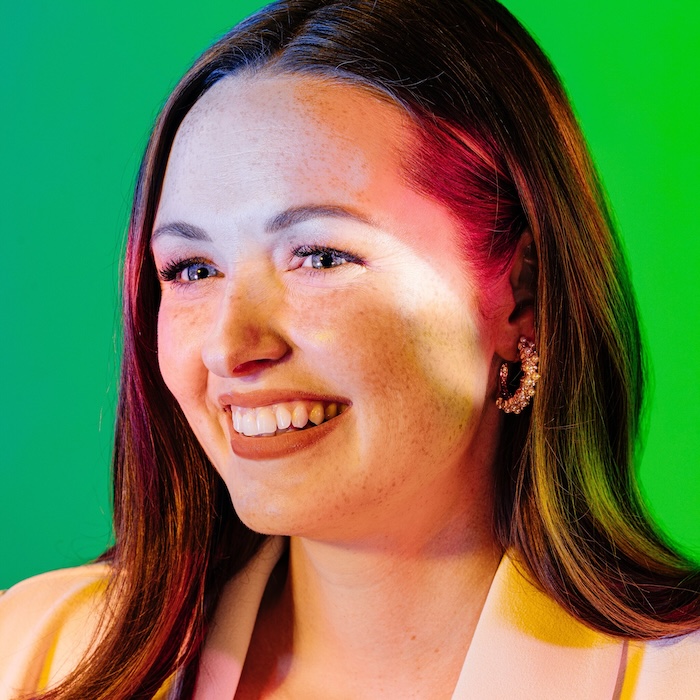
By David Marchese
A decade ago, Hadley Vlahos was lost. She was a young single mother, searching for meaning and struggling to make ends meet while she navigated nursing school. After earning her degree, working in immediate care, she made the switch to hospice nursing and changed the path of her life. Vlahos, who is 31, found herself drawn to the uncanny, intense and often unexplainable emotional, physical and intellectual gray zones that come along with caring for those at the end of their lives, areas of uncertainty that she calls “the in-between.” That’s also the title of her first book, which was published this summer. “The In-Between: Unforgettable Encounters During Life’s Final Moments” is structured around her experiences — tragic, graceful, earthy and, at times, apparently supernatural — with 11 of her hospice patients, as well as her mother-in-law, who was also dying. The book has so far spent 13 weeks on the New York Times best-seller list. “It’s all been very surprising,” says Vlahos, who despite her newfound success as an author and her two-million-plus followers on social media, still works as a hospice nurse outside New Orleans. “But I think that people are seeing their loved ones in these stories.”
What should more people know about death? I think they should know what they want. I’ve been in more situations than you could imagine where people just don’t know. Do they want to be in a nursing home at the end or at home? Organ donation? Do you want to be buried or cremated? The issue is a little deeper here: Someone gets diagnosed with a terminal illness, and we have a culture where you have to “fight.” That’s the terminology we use: “Fight against it.” So the family won’t say, “Do you want to be buried or cremated?” because those are not fighting words. I have had situations where someone has had terminal cancer for three years, and they die, and I say: “Do they want to be buried or cremated? Because I’ve told the funeral home I’d call.” And the family goes, “I don’t know what they wanted.” I’m like, We’ve known about this for three years! But no one wants to say: “You are going to die. What do you want us to do?” It’s against that culture of “You’re going to beat this.”
Is it hard to let go of other people’s sadness and grief at the end of a day at work? Yeah. There’s this moment, especially when I’ve taken care of someone for a while, where I’ll walk outside and I’ll go fill up my gas tank and it’s like: Wow, all these other people have no idea that we just lost someone great. The world lost somebody great, and they’re getting a sandwich. It is this strange feeling. I take some time, and mentally I say: “Thank you for allowing me to take care of you. I really enjoyed taking care of you.” Because I think that they can hear me.
The idea in your book of “the in-between” is applied so starkly: It’s the time in a person’s life when they’re alive, but death is right there. But we’re all living in the in-between every single moment of our lives. We are.
So how might people be able to hold on to appreciation for that reality, even if we’re not medically near the end? It’s hard. I think it’s important to remind ourselves of it. It’s like, you read a book and you highlight it, but you have to pick it back up. You have to keep reading it. You have to. Until it really becomes a habit to think about it and acknowledge it.
I was reading these articles recently about how scientists are pursuing breakthroughs that could extend the human life span to one hundred twenty.1
1
Examples of which could include devising drug cocktails that get rid of senescent cells and filtering old blood to remove molecules that inhibit healing.
There’s some part of people that thinks they can cheat death — and, of course, you can’t. But what do you think about the prospect of extending the human life span? I don’t want to live to be 120. I have spent enough time around people who are close to 100, over 100, to know that once you start burying your children, you’re ready. Personally, I’ve never met someone 100 or older who still wants to be alive. I have this analogy that I did a TikTok2
2
Vlahos has 1.7 million followers on TikTok, where she posts about her experience as a hospice nurse and often responds to questions about death and dying.
on. This is from having a conversation with someone over 100, and her feeling is that you start with your Earth room when you’re born: You have your parents, your grandparents, your siblings. As you get older, your Earth room starts to have more people: You start making friends and college roommates and relationships. Then you start having kids. And at some point, people start exiting and going to the next room: the afterlife. From what she told me, it’s like you get to a point when you’re older that you start looking at what that other room would be, the afterlife room,3
3
According to a 2021 Pew Research survey, 73 percent of American adults say they believe in heaven.
and being like, I miss those people. It’s not because you don’t love the people on Earth, but the people you built your life with are no longer here. I have been around so many people who are that age, and a majority of them — they’re ready to go see those people again.
“The In-Between” also has to do with the experience of being in between uncertainty and knowing. But how much uncertainty is there for you? Because in the book you write about things that you can’t explain, like people who are close to death telling you that they’re seeing their dead loved ones again. But then you write, “I do believe that our loved ones come to get us when we pass.”4
4
From Vlahos’s book: “I don’t think that we can explain everything that happens here on Earth, much less whatever comes after we physically leave our bodies. I do believe that our loved ones come to get us when we pass, and I don’t believe that’s the result of a chemical reaction in our brain in those final hours.”
So where is the uncertainty? The uncertainty I have is what after this life looks like. People ask me for those answers, and I don’t have them. No one does. I feel like there is something beyond, but I don’t know what it is. When people are having these in-between experiences of seeing deceased loved ones, sometimes it is OK to ask what they’re seeing. I find that they’ll say, “Oh, I’m going on a trip,” or they can’t seem to find the words to explain it. So the conclusion I’ve come to is whatever is next cannot be explained with the language and the knowledge that we have here on Earth.

Do these experiences feel religious to you? No, and that was one of the most convincing things for me. It does not matter what their background is — if they believe in nothing, if they are the most religious person, if they grew up in a different country, rich or poor. They all tell me the same things. And it’s not like a dream, which is what I think a lot of people think it is. Like, Oh, I went to sleep, and I had a dream. What it is instead is this overwhelming sense of peace. People feel this peace, and they will talk to me, just like you and I are talking, and then they will also talk to their deceased loved ones. I see that over and over again: They are not confused; there’s no change in their medications. Other hospice nurses, people who have been doing this longer than me, or physicians, we all believe in this.
Do you have a sense of whether emergency-room nurses5
5
Who, because of the nature of their jobs, are more likely than hospice nurses to see violent, painful deaths.
report similar things? I interned in the E.R., and the nurse I was shadowing said that no one who works in the E.R. believes in an afterlife. I asked myself: Well, how do I know who’s correct? How am I supposed to know? Are the people in the church that I was raised with6
6
Vlahos was raised in an Episcopalian family. She now refers to herself, as so many do, as spiritual rather than religious
more correct than all these people? How are you supposed to know what’s right and what’s not?
But you’ve made a choice about what you believe. So what makes you believe it? I totally get it: People are like, I don’t know what you’re talking about. So, OK, medically someone’s at the end of their life. Many times — not all the time — there will be up to a minute between breaths. That can go on for hours. A lot of times there will be family there, and you’re pretty much just staring at someone being like, When is the last breath going to come? It’s stressful. What is so interesting to me is that almost everyone will know exactly when it is someone’s last breath. That moment. Not one minute later. We are somehow aware that a certain energy is not there. I’ve looked for different explanations, and a lot of the explanations do not match my experiences.
That reminds me of how people say someone just gives off a bad vibe. Oh, I totally believe in bad vibes.
But I think there must be subconscious cues that we’re picking up that we don’t know how to measure scientifically. That’s different from saying it’s supernatural. We might not know why, but there’s nothing magic going on. You don’t have any kind of doubts?
None. Really? That’s so interesting. You know, I read your article with the atheist.7
7
“How to Live a Happy Life, From a Leading Atheist,” an interview with the philosopher Daniel C. Dennett, published in August.
I feel like you pushed back on him.
There are so many things in our lives, both on the small and the big scale, that we don’t understand. But I don’t think that means they’re beyond understanding. OK, you know what you would like? Because I know that you’re like, “I believe this,” but you seem to me very interested; you’re not just set in your ways. Have you ever heard that little story about two twins in a womb?8
8
Known as the parable of the twins, this story was popularized by the self-help author Dr. Wayne W. Dyer in his 1995 book “Your Sacred Self: Making the Decision to Be Free.”
I’m going to totally butcher it, but essentially it’s two twins who can talk in the womb. One twin is like, “I don’t think that there is any life after birth.” And the other is like, “I don’t know; I believe that there is something after we’re born.” “Well, no one’s ever come back after birth to tell us that there is.” “I think that there’s going to be a world where we can live without the umbilical cord and there’s light.” “What are you talking about? You’re crazy.” I think about it a lot. Do we just not have enough perspective here to see what could come next? I think you’ll like that story.
For the dying people who don’t experience what you describe — and especially their loved ones — is your book maybe setting them up to think, like: Did I do something wrong? Was my faith not strong enough? When I’m in the home, I will always prepare people for the worst-case scenario, which is that sometimes it looks like people might be close to going into a coma, and they haven’t seen anyone, and the family is extremely religious. I will talk to them and say, “In my own experience, only 30 percent of people can even communicate to us that they are seeing people.” So I try to be with my families and really prepare them for the worst-case scenario. But that is something I had to learn over time.
Have you thought about what a good death would be for you? I want to be at home. I want to have my immediate family come and go as they want, and I want a living funeral. I don’t want people to say, “This is my favorite memory of her,” when I’m gone. Come when I’m dying, and let’s talk about those memories together. There have been times when patients have shared with me that they just don’t think anyone cares about them. Then I’ll go to their funeral and listen to the most beautiful eulogies. I believe they can still hear it and are aware of it, but I’m also like, Gosh, I wish that before they died, they heard you say these things. That’s what I want.
You know, I have a really hard time with the supernatural aspects, but I think the work that you do is noble and valuable. There’s so much stuff we spend time thinking about and talking about that is less meaningful than what it means for those close to us to die. I have had so many people reach out to me who are just like you: “I don’t believe in the supernatural, but my grandfather went through this, and I appreciate getting more of an understanding. I feel like I’m not alone.” Even if they’re also like, “This is crazy,” people being able to feel not alone is valuable.
This interview has been edited and condensed for clarity from two conversations.
Complete Article ↪HERE↩!
Does Thinking About Dying Increase Your Risk Of Death?

By Tricia Goss
The human mind and body are intricately connected. The relationship between the two is so profound that it can significantly impact our well-being. Whether thinking about death increases the risk of death delves deep into this complex relationship. The age-old saying “mind over matter” suggests that our thoughts have the power to shape our physical reality, and scientific research supports this notion.
Psychoneuroimmunology studies how emotions, thoughts, and beliefs affect the immune and nervous systems (via Reference Module in Neuroscience and Biobehavioral Psychology 2017). A 2017 study in Physiological Reviews shows that the brain communicates directly with the immune system, releasing chemicals and hormones that can profoundly impact how your body functions. Stress hormones like cortisol, released when we experience psychological stress, can lead to health problems like cardiovascular issues and weakened immune responses (per the Mayo Clinic).
The placebo and nocebo effects illustrate this even further. Believing that a treatment will work can trigger remarkable healing responses, while negative expectations can have detrimental consequences.
Ultimately, it’s clear that our thoughts and physical well-being are intricately connected. By exploring the science behind psychosomatic illnesses and how the fear of death influences health, we can better understand how our thoughts shape our bodies’ realities.
Psychosomatic illnesses and their impact
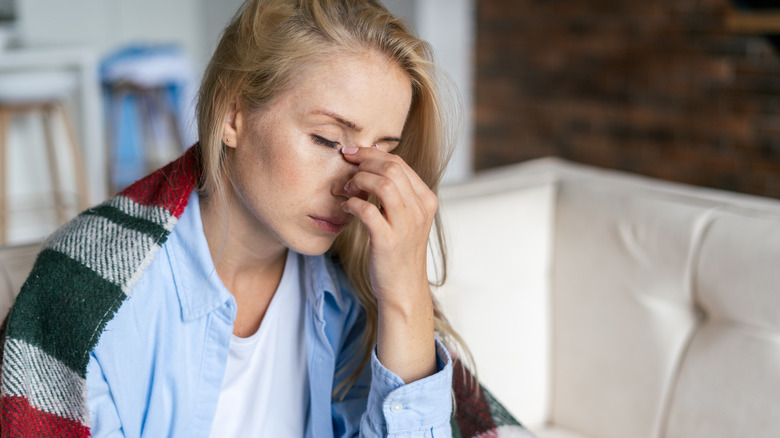
Psychosomatic illnesses are physical conditions stemming from psychological factors like stress, anxiety, or emotional distress. Studies have consistently shown how psychological distress can trigger or worsen various physical health issues (per Healthline). For instance, 2014 research published in the World Journal of Gastroenterology highlighted that patients with IBS often exhibit high levels of anxiety and stress, which can worsen their symptoms.
Additionally, psychosomatic illnesses can affect our hearts. According to 2021 research published in Circulation, negative psychological factors — such as stress, anxiety, and depression — can increase our risk of developing cardiovascular disease (CVD). In contrast, positive psychological factors — such as optimism, resilience, and social support — can reduce our risk of developing the disease.
Similarly, psychological factors also play a significant role in chronic pain conditions. For example, a 2017 report in Neural Plasticity demonstrated a link between depression and chronic pain.
These examples provide compelling evidence of the profound connection between the mind and body.
The positive aspects of mortality awareness
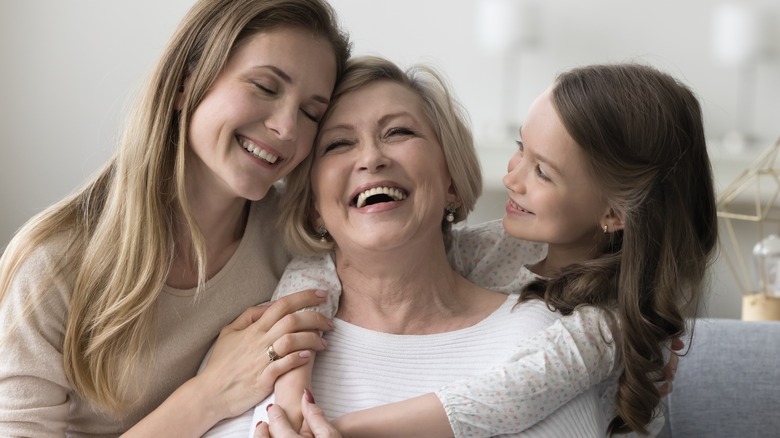
The idea of mortality is a complicated issue that encourages us to explore the depths of our human experience. Realizing that your time on this planet is limited can bring about many emotions, such as fear, anxiety, and despair. However, this realization can also provide you with an opportunity for personal growth and positive change. It urges you to reflect on your life, evaluate your priorities, and cherish every moment.
Embracing life’s impermanence can be a powerful catalyst for personal growth as well as developing and changing habits. It can help motivate you to live a more authentic, meaningful, and purposeful life. By accepting that life is fleeting, you can be inspired to wake up each day with a sense of purpose and gratitude for the world around you. By facing your fears with resilience and courage, you’ll learn to appreciate life’s uncertainties and make the most of the time you have.
What to do if thinking about dying causes anxiety

While it’s important to recognize that death is a natural part of life, it’s also vital to avoid fixating on it and letting it cause undue stress or anxiety. The good news is that there are plenty of constructive steps we can take to address our concerns and maintain a positive outlook on life. A study published in 2022 in Current Psychology has shown that people who find meaning in their lives and can effectively manage stress are less likely to experience death anxiety. This means growing and cultivating resilience in the face of existential fears is possible.
If you worry about death frequently or feel like these fears are starting to impact your daily life, seeking mental health support is a great way to be proactive and get the help you need. Mental health therapists and psychologists can offer guidance, coping strategies, and emotional support to help you navigate your fears and feel more resilient. By embracing the challenges of mortality and seeking support when needed, you can lead a more balanced, fulfilling life and face life’s uncertainties with greater confidence.
Complete Article ↪HERE↩!
Death is inevitable
— Why don’t we talk about it more?

Death is hard to talk about. But death doula Alua Arthur says if we want to live presently and die peacefully, we have to radically reshape our relationship with death.
About Alua Arthur
As a death doula, Alua Arthur help individuals and families to navigate the emotional, legal and spiritual issues that arise around death. Arthur worked as an attorney prior to entering the field of “death work.” Her organization, Going with Grace, educates fellow death doulas in nonmedical end-of-life care. Her forthcoming book, Briefly Perfectly Human, reframes how we think about dying.
Arthur was recently featured in the National Geographic television series Limitless, in which she helped actor Chris Hemsworth map out his own future death. She has been featured in the Los Angeles Times, Vogue, InStyle and more. She is a former director of the National End-of-Life Doula Alliance.
Thanatophobia (Fear Of Death)
— Symptoms And Treatment
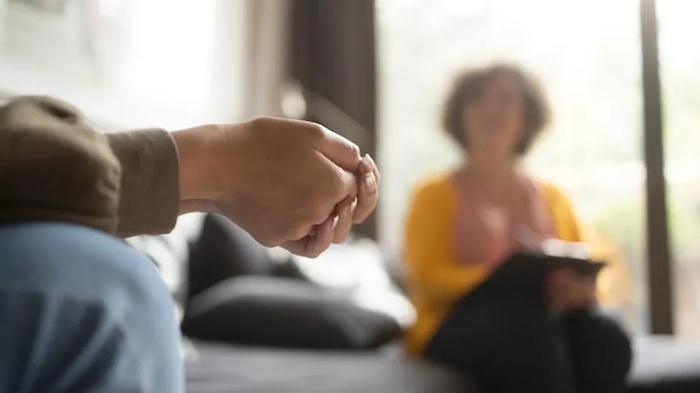
It’s natural to worry about death—whether it’s your own or a loved one’s. But for those with thanatophobia, feelings of worry and anxiety over dying are so intense, it impacts their ability to function day-to-day.
Though death is unavoidable, it’s possible to overcome thanatophobia. This requires knowing the symptoms, understanding the reasons why it can develop, being properly diagnosed and working with a mental health professional. When left untreated, fear of death can prevent one from living the full life they deserve to live.
What Is Thanatophobia?
Thanatophobia is the fear of death or the dying process. “We all fear things, and many people are afraid of death,” says Jenna DiLossi, Psy.D., a specialist in phobias and the co-founder of the Center For Hope and Health located in Pennsylvania. “But a phobia has a certain level of intensity and pervasiveness of fear.”
Rachel Menzies, Ph.D., is a clinical psychologist, the director of the Menzies Anxiety Centre in Australia and a leading expert on thanatophobia. She has written several books on the topic, including Free Yourself From Death Anxiety. Thanatophobia can involve fear of death itself or the dying process, she explains. “It could be related to the fear of not existing one day or it could be the fear of death being really painful,” she says. Thanatophobia can also mean having a phobia of others’ dying, she adds.
The difference between having a “normal” fear of death and a true phobia is the level it impacts one’s daily life, says Dr. DiLossi. For example, someone with thanatophobia may avoid certain activities, such as driving, because they worry it will kill them.
Thanatophobia is not in the Diagnostic and Statistical Manual of Mental Disorders, Fifth Edition (DSM-5); instead it’s considered a “specific phobia.” The criteria for being diagnosed with a specific phobia is as follows:
- Fear about a specific object or situation (in this case, death or dying)
- The situation almost always causes immediate fear or anxiety
- The fear is disproportionate to the actual danger
- The situation is actively avoided or endured with intense anxiety
- The fear impacts one’s daily life, such as their social life or job
- The fear has been present for at least six months
- It cannot be explained by symptoms of another mental health disorder
Dr. Menzies emphasizes that feeling queasy or anxious about death is natural. It’s when the anxiety surrounding death starts impacting one’s daily life that it’s considered a phobia. For example, someone with thanatophobia may be unable to focus at work or the phobia gets in the way of them pursuing meaningful activities, such as traveling, she says.
Thanatophobia Causes and Risk Factors
Both experts say that anyone can be thanatophobic; both old and young people, people who have strong religious beliefs and people who don’t, people who are physically healthy and people who are sick. However, there are some risk factors that can make someone more likely to experience this specific fear. Both experts say that individuals with obsessive compulsive disorder (OCD) are more likely to be thanatophobic. Dr. Menzies explains that for some people with OCD, the reason why they engage in compulsive habits (such as hand washing) is because they believe it will prevent something bad from happening, such as an untimely death.
Women are more likely than men to have thanatophobia since women tend to have more general anxiety than men, says. Dr. Menzies. Research also shows that people in middle age are more likely to have a fear of death than elderly adults. Dr. Menzies hypothesizes that older people may be less anxious about death because they come to accept it more, in part by seeing others die. However, she notes that witnessing someone experiencing a painful or traumatic death can also make thanatophobia more likely.
In terms of the link between religious beliefs and thanatophobia, anecdotally, Dr. Menzies has noticed in her clinical practice that people who are unsure of their beliefs tend to be more fearful of death than those who believe strongly in what will happen after death.
“Both very committed religious believers and committed atheists are less likely [to be thanatophobic] than people in the middle who are uncertain about the afterlife,” she says. Scientific studies show there is not a connection between one’s specific religious beliefs (such as Christian or Muslim) and the likelihood of having a fear of death.
Thanatophobia Diagnosis
As previously mentioned, thanatophobia is not its own specific condition included in the DSM-5. The closest diagnosable condition is “specific phobia,” says Dr. DiLossi. When diagnosing someone with thanatophobia, clinicians refer to the list of criteria for specific phobia, she explains.
Both experts emphasize that the main sign that someone is thanatophobic is that their fear of death (either their own or someone else’s) is impacting their daily life. This can include getting in the way of work (such as being unable to focus), being preoccupied during social events (such as being unable to enjoy spending time with friends or family due to being preoccupied by thoughts of death) or avoiding meaningful activities because of the fear that it will lead to death (even though the risk for this happening is low).
Thanatophobia Treatment
With professional help, thanatophobia is treatable. According to both experts, as with other phobias, the most common treatment for thanatophobia is cognitive behavioral therapy (CBT), a psychological treatment that examines what one thinks and what one does. First, a therapist will explore where the client’s fear of death stems from. They will also ask about the ways this fear is limiting their life. Then, they will work through actionable steps so that it no longer holds them back.
For some individuals, longer term and more intensive psychodynamic and existential therapies are needed if the symptoms of their thanatophobia return after CBT.
With other phobias (such as spiders, driving or heights), both experts explain that CBT uses exposure therapy to incrementally help someone become more comfortable with the object or circumstance surrounding their fear. For example, someone with a fear of driving may look at a car, then work up to sitting in a car and then eventually driving it. Working through a fear of death has similarities and differences; for example, Dr. Menzies says that she may have a thanatophobic client start by reading the obituaries. Then, she may ask them to plan their funeral or will. “Really anything that moves toward acceptance of death and away from denial or avoidance [will help],” she says.
Unlike with other phobias, Dr. Menzies says that being around death itself is not part of overcoming thanatophobia. Treatment also does not involve doing risky activities that would jeopardize one’s safety, says Dr. DiLossi.
Living With Thanatophobia
Death is inevitable. This raises an interesting question: How does the death of a loved one impact someone with thanatophobia? “For some people, this experience will actually help them cultivate an acceptance of death, particularly people who are desperately trying to prevent their own death,” says Dr. Menzies. But for others, the death of a loved one can exacerbate their fear, making it worse. “It greatly depends on the circumstances surrounding the death,” she says. “Was the person in pain? Was it peaceful?”
If the death of a loved one has made someone’s fear of death more pronounced, it’s especially important to reach out to a mental health provider who can provide actionable tips based in CBT that can help them cope, says Dr. Menzies.
Both experts say that overcoming thanatophobia does not mean that someone will not be fearful of death at all; what it means is that their fear will not impact their daily life.
When to See a Doctor
If a fear of death is impacting your daily life, it’s important to see a mental health provider who specializes in phobias or CBT, experts note. One way to find a CBT therapist near you is by using the directory created by the Association for Behavioral and Cognitive Therapies. You can also see your primary health care provider, who can connect you to a mental health provider.
“There’s a misconception that since death is unavoidable, people with this phobia need to just ‘get over it.’ That is untrue. There is specific treatment for thanatophobia,” Dr. Menzies says, referring to CBT. “There is very good evidence that people can overcome thanatophobia. This is not something someone has to live with.”
Complete Article ↪HERE↩!
Meditating on my death made me feel thrilled to be alive
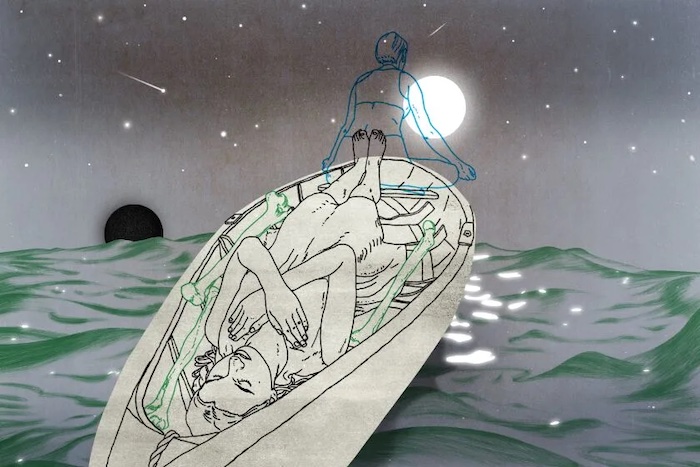
By Deborah Netburn
On a recent Saturday night, the scene was serene inside Tac-tile Mountain, a small, carefully curated shop in Pasadena. The meditation cushions were laid out on the concrete floor. A sea of white candles was flickering in the window. And then the restaurant next door started blasting “Umbrella” by Rihanna.
The six of us who had gathered inside laughed nervously. We were already excited and a little hesitant. After all, we were there to contemplate our own deaths.
Tac-tile Mountain was hosting “Death Reflections,” a two-hour, $55 workshop led by Marifel Catalig, a trained death doula and breathwork instructor. It had been advertised on Instagram as “a breath guided meditation intended to contemplate death in many forms.” The description ended there, so no one knew exactly what to expect.
Going into the workshop, I hoped that spending an hour meditating on my inevitable demise would ease my fear of dying. What I didn’t anticipate is that I would walk out feeling profoundly grateful for all the ordinary, messy, glittering life I’ve been blessed to live so far.
“What I have been seeing for 15 years now is that knowing one has to die allows one to value life, and feel more grateful for what life allows us to do and enjoy,” she said.
Catalig, 40, greeted us at the door wearing a white blouse and wide-legged jeans, and then asked us to find our seats. After lighting the candles that were placed at the head of each of our cushions, we began with a gentle movement to release the tension of the day, and then focused on our senses — paying close attention to what we could see, hear, taste, feel and smell.
Death meditations are wildly variable. In the Buddhist tradition the practice of maraṇasati, or mindfulness of death, is designed to remind practitioners that death might come as soon as the next morning, the next meal or even the next breath, and encourage them to act accordingly. Another Buddhist practice focuses on a detailed visualization of the body’s eventual decay to help relinquish attachment to the material world.
Catalig once attended a death meditation where participants were wrapped in a white sheet to mimic the shroud they might wear after they die. Another time she led a living funeral workshop where people were asked to write a eulogy for themselves that she read out loud to the group.
The meditation I attended was simpler. The focus was primarily on the type of life review many people undertake before they die.
Accompanied by a playlist of instrumental music that was more evocative than annoying, Catalig asked us to imagine our earliest memories and consider where we were, who was there, what we felt like, what it smelled like and what sounds we heard. We did the same for our early childhood, pre-adolescence, adolescence, early adulthood and on.
As she spoke, memories of the many lives I’ve lived flashed through my mind. Most of them were mundane, but they filled me with a sense of tenderness. There I was playing with a Fisher-Price barn on a green carpet, walking to school in new saddle shoes, riding bikes on the sidewalk with my sister. I saw sleepovers and middle school dances, late summer nights wandering around my hometown, blissfully bored and aimless.
Nobody has lived your life but you. All of your experiences, everything that got you here, that belongs to you.
— Marifel Catalig, breathwork instructor
I saw scenes from my adult life before kids, my life as a new parent, my life with small children and, finally, my life now — my husband, my teenage sons, my colleagues, my friends. All the different and distinct lives I’ve lived.
“Nobody has lived your life but you,” Catalig said. “All of your experiences, everything that got you here, that belongs to you.”
Then the music shifted and she asked us to imagine that we were nearing death. Our eyesight was fading, our hearing becoming more muffled. Food didn’t taste as good as it once did and we were eating less. In my mind I felt myself receding from the immediacy of life — a fog of gray between me and the world. As my experience of the world became more muted, I felt less afraid of leaving it.
Then Catalig had us imagine our last days. Who would visit us? What would they say? And then we pictured our last breath. “What do you want to breathe in?” she asked. “And what do you want to breathe out?”
We imagined hovering above our lifeless bodies, what they would look like, and who would tend to them. For a brief moment, we imagined what might be next.
In a society that rarely encourages reflections on death and dying, many of us respond to our innate fear of death with denial, Testoni said. Carving out time to visualize and imagine our own passing can help us face that fear in a productive way.
“Reflection makes us realize that we are afraid of something we do not know,” she said. “Knowing that we don’t know but we can know a lot is definitely reassuring.”
When the meditation was over, Catalig invited us to share about the experience.
One participant said the meditation helped her reframe the times in her life when she thought she was a bad person. Instead, she saw herself with more compassion. Another participant said she felt that her higher self had been with her all along, and was still with her. This brought her great comfort.
As for me, I walked out of the store in a state of elation. I was less afraid of dying, but mostly I felt so thrilled to be alive.
If you’re curious to try one of Catalig’s death meditations, you can find future offerings on her Instagram page, or contact her through her website breathtodeath.com.
Complete Article ↪HERE↩!
Almost everyone fears death
— But not in the same ways
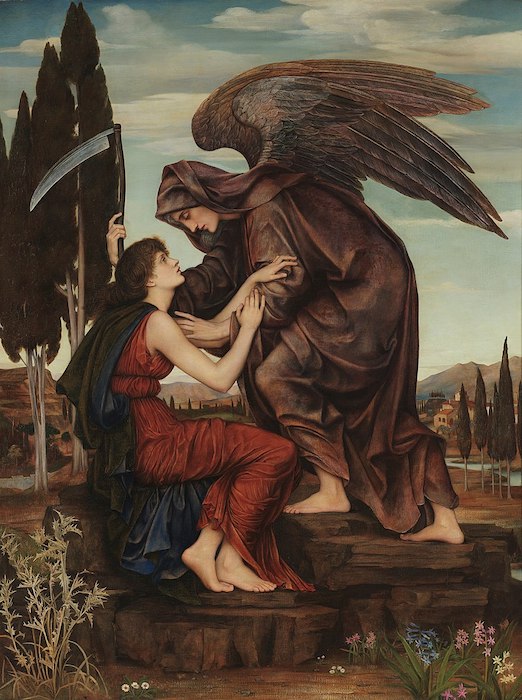
Angel of Death, Evelyn De Morgan, circa 1881
“It is healthy and normal to be afraid of death.”
By Ross Pomeroy
- Fear of death may be the most primal human fear, one we all experience differently.
- People who are older, in committed relationships, physically healthy, and either very religious or not religious at all tend to be less afraid of death.
- When the fear of death becomes extreme and life-disrupting, by far the most effective remedy is cognitive behavioral therapy.
Humans may be the only species fully aware of the inevitability of death. William James, considered by many to be the “father of American psychology,” famously called this fateful knowledge the “worm at the core” of human existence. This metaphorical worm today forms the basis of terror management theory, which proposes that awareness of our mortality, coupled with our self-preservation instinct, produces a primal terror that we constantly struggle to manage. To do so, we often form beliefs and take actions that provide meaning and value that we hope persist beyond our own demise, granting us a semblance of immortality. Other times, we simply cope through escapism or denial.
But just as we all deal differently with the omnipresent foreboding of mortality, so too do we fear death in distinct ways. As Cara Santa Maria, a popular science communicator pursuing a PhD in clinical psychology with a focus on end-of-life care, noted on the Skeptics’ Guide to the Universe podcast:
“Some people are afraid of oblivion. Some people are afraid of dying — the pain, the disability. Some people are afraid of leaving people behind. They’re afraid of leaving things unfinished. They’re afraid of not having a legacy. There are so many different ways that we can be afraid of death.”

Surveys suggest that common fears surrounding death are tied to the prospect of leaving loved ones behind and the dying process itself.
However, certain life choices may ameliorate the fear of death. Being married or in a committed relationship is a significant comfort. Being in good physical health helps, too. This may be because it creates more meaning in life and is broadly linked to better mental health or simply that it grants the perception that the Grim Reaper is farther away. Those on opposite ends of the religiosity spectrum also tend to be less afraid of death. Atheists tend to be more relaxed and “in-the-moment,” while strong believers take comfort in knowing there’s an afterlife and that their life has meaning.
Perhaps most comforting, we tend to grow less afraid of death as we get older. As Jade Wu, a clinical health psychologist at Duke University, writes: “This could be because older people have experienced more of life, so they have less fear of missing out. Or it might be because they have more experience with witnessing and handling the death of others.”
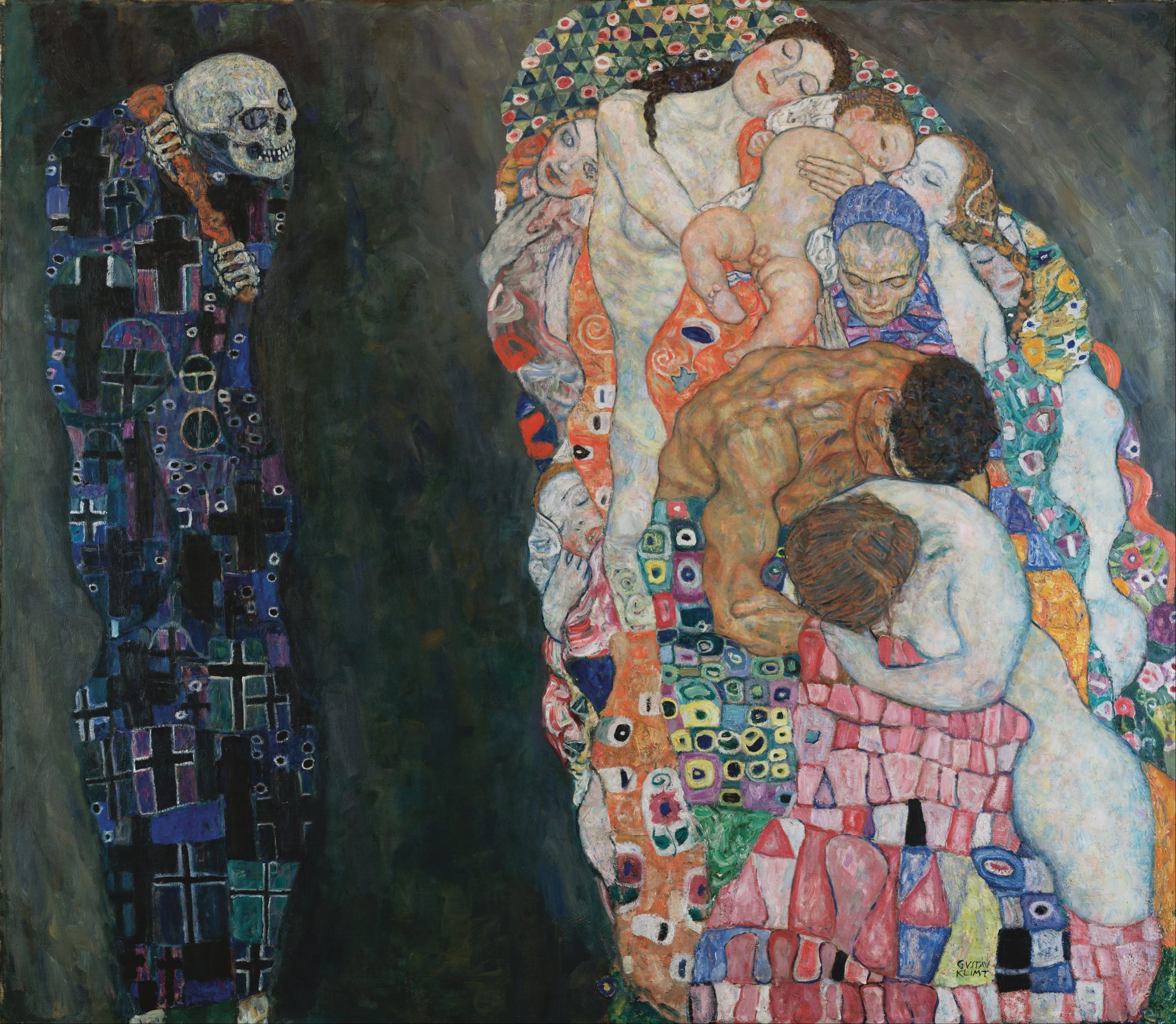
For some, however, the fear of death can be hard to handle, developing into what’s termed thanatophobia.
“It is healthy and normal to be afraid of death, but when we venture into these pathological fears where it becomes all-consuming and it starts to interfere with our activities of daily living, there are things that we can do therapeutically,” Santa Maria said.
By far the most effective remedy is cognitive behavioral therapy. A certified therapist will help a death-fearing client to challenge their anxiety-inducing assumptions about dying and then expose the client to death in ways that will alleviate their fears. Such exposure may include watching movies with scenes that depict the end of life, reading hospice materials, or developing a plan for their own passing.
According to clinical therapist Brittney Chesworth, clients “steadily see death as a normal part of life and not the ‘scary monster in the closet.’”
Complete Article ↪HERE↩!
The Art of Dying
— Overcoming Our Fear of Death

Enduring, accepting, and embracing the inevitability of one of mankind’s greatest fears.
By Jocelyn Tatum
On my desk at home, I have a true-to-life-sized concrete sculpture of a skull with little porcelain bluebirds resting on its mouth, ears, eyes, and one on its crown. I found it at ArtsGoggle in Fort Worth 13 years ago when the local arts festival was just starting out. I gravitated toward it because it reminded me how fleeting and fragile life can be. The birds, to me, represented the creativity that comes forth in the face of our finitude. The idea was that this mortal reminder would help me get past writer’s block. After all, as a journalist, these stories are not my own. They are your stories. I am merely the vessel who delivers them using my passion and acute sensitivity to humanity. And I borrowed this idea from 14th-century monks who kept skulls on their desks as a reminder of their mortality as they wrote their philosophical dissertations, so this idea wasn’t new. “For dust you are, and to dust you shall return.” Sounds familiar, right? This symbol of death on my desk was a reminder to face my fears head on, and that I am just passing through this world, adding my thread to the massive tapestry that is the story of all us.
I have always thought of myself as a pilgrim. Just passing through. The joys in life like my son, friendships, or romantic partners are merely finite gifts lent to me from the universe, never mine to keep or clutch. I have found that the pain is in the clinging to life or avoidance thereof, whether it is my own or another’s. Peace and serenity lie somewhere in the middle. Everything temporal, everything passing. Life doesn’t have to be so serious, and I think my journey exploring my own non-imminent death has reminded me of this. When achieved, this allows me to live with a free spirit and detachment to the things that weigh me down. And as things have gotten heavier for me lately with my father starting palliative care for his cancer and the loss of a great love in a breakup, I decided it was time to stare death and grief boldly in the face.
Two Fort Worth women just launched their business, The Art of Dying, in January 2023 after completing their death doula training. When I came across their Instagram (@theartofdyingfw), I became curious. Very curious. So, I kept digging. It turns out that a death doula is like a birth doula but assists with the process of dying. They are an end-of-life companion who can guide the dying, whether that is connecting them to a number of resources or inspiring ideas for how to celebrate the life they have left. “The Art of Dying [is a] small collective that offers support, celebration, and companionship to individuals and their loved ones through the end of life.” They offer services for those who have a terminal diagnosis or those who want to plan early in life and are non-imminent.
These end-of-life practices have been steadily growing since the pandemic, according to Alvin Harmon, the head of the National End-of-Life Doula Alliance on an NPR news segment that aired Jan. 17. “How people died, that was what became important, having that safe space, that whole space, people dying in a manner that felt safe to them and was important to them,” Harmon said on air. Any little dignity people had left when dying was stripped of the dying during the isolating loss of COVID-19. This phenomenon led Fort Worth’s Lacy Buynak to get her death doula training. She lost her grandmother during the pandemic.
“As I was grieving her death, I was having this huge collective grief for all of these people who didn’t get that,” she says as tears form in the corners of her eyes. “I started thinking that that has got to be one of the worst ways to go.” She got to say goodbye to her one last time before she died but realized so many others did not have this experience.
Now business partners in all thing’s death, Buynak and Taykor Bell had been friends since attending school together in 2001. Twenty years later, in April 2021, Buynak called Bell to catch up. They had been talking about something else when Buynak said, “I did a crazy thing. I signed up for a training program to be a death doula.” She remembers getting a “holy-shit, so-did-I”-type of response.
The two had been keeping an ear on the heartbeat of death for years as a separate fascination while a parallel nationwide phenomenon of making death more palatable, eco-friendly, meaningful, and even enjoyable was disrupting the $20 billion funeral industry, which celebrity mortician death advocate Caitlin Doughty argues exploits people’s grief and turns it into a profit. After their own experience with death, Buynak and Bell saw a need to provide a comprehensive and holistic service in Fort Worth that also educates the community one death at a time. “We want to hold space for people in those moments. Raising awareness for collectivism, the practice or principle of giving a group priority over an individual, for being there for people,” Bell says.
Bell had her first existential crisis in grade school. She thought about dying and going to heaven and thought, “That is forever.” Her mind kept seeing “road barriers” to this thought of permanence, and anything past that scared her (to death). She couldn’t understand forever. For her, something so big and unknown brought up this debilitating fear. She knew then that death would be her biggest teacher, and her training for this vocation is her life experience. Not only has she read many books over her 40 years alive, but she was able to be there for her mother as she was dying in a way that she would want someone to be there for her. It occurred to her that many people die in the most isolated and sterile way in the U.S. even before the pandemic.
“The vision is to put ourselves out of business to remind our culture to do this for each other. This is a business needed more than ever. There are so many ways people can feel vulnerable and alone, and death is when that is most poignant,” Bell says.
This year marks the 10th year since Bell’s mother died of adrenal cancer. The story gave me chills. When Bell decided to leave her current career, she looked at the amount of money her mother left her, an account she was hesitant to touch because it was the last lifeline to her mom, and it was the exact amount she needed to get her death doula training. Then Buynak called.
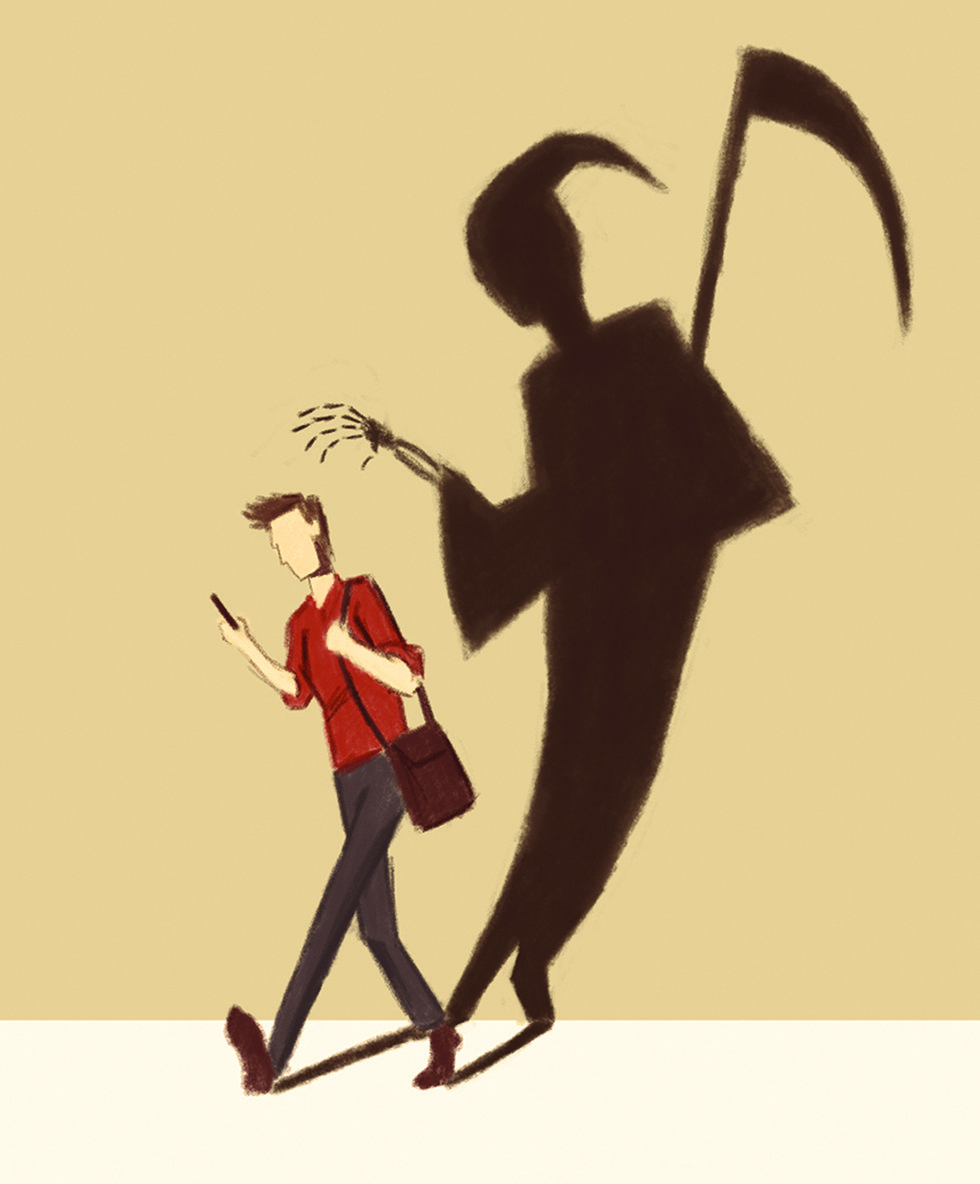 Illustrations by Brandon Hayman[/caption]
Illustrations by Brandon Hayman[/caption]
My Journey
I met with Bell and Buynak for sparkling tea at Leaves Book and Tea Shop in Fort Worth’s SoMa district. They had a big biodegradable binder waiting for me on the table with their logo on the front. Page 1: “In this binder, you will find a comprehensive list of legal documents to gather, logistics and arrangements to consider, as well as various comfort and care services you may be interested in learning more about.”
Section 1, “Legal: Advance Directive, Durable Power of Attorney, Last Will and Testimony.” This is definitely the least enjoyable part of the process. I went to the websites, which was about what I expected from government sites. Then I had to download a bunch of PDFs to print, fill them out, and then take them to be notarized. Then file them. Bell recommended using RocketLawyer (not a shameless plug) unless you have some massive estate to work through.
Not going to lie, this part made me feel uncomfortable. Itchy. It asks a lot of questions that I really don’t feel like I know the answers to yet. And when it got to the body disposition authorization that included some subtext about whether your body remains are acceptable if you want to donate it to science, I had to step away and get some fresh air. “So you’re saying my body could be rejected even after I die?” I thought.
“We want people 40 and younger to get their [act] together. It can be sad, confusing, and beautiful,” Bell told me regarding the Art of Preplanning, a service they offer to those who get their affairs in order even if death isn’t imminent.
Well, I do not have my act together. And I am not going to lie, this has brought up some feelings. So, I decide once more to procrastinate on the legal paperwork, which Bell and Buynak have both said I need to knock out first because something can happen to us at any moment. Digging into the resistance, I redirected my efforts into research about how to overcome this fear. What I found brought me peace beyond what I could have ever expected.
Overcoming Fears
“The cave you fear to enter holds the treasure you seek,” said 20th century author Joseph Campbell.The New York Times reported a phenomenon in an article titled “South Koreans, Seeking a New Zest for Life, Experience Their Own Funerals” where people choose to face their mortality. “After an instructional lecture and video, participants are led into a dimly lit hall decorated with chrysanthemums, where they sit, often tearfully, beside caskets and write their last testaments. Then they put on burial shrouds and lie down in the coffins,” the article reports. What surprised me is many participants photographed were young and healthy with no end in sight, but some had a terminal illness and wanted to prepare while others struggled with suicidal thoughts and wanted to put those to rest. They reported emerging from their mock funerals and meditations around death with a new and hopeful perspective on life.
Buddhist monks contemplate images of decaying bodies to unlock the door living in the present and letting go of fears. “It makes disciples aware of the transitory nature of their own physical lives and stimulates a realignment between momentary desires and existential goals. In other words, it makes one ask, ‘Am I making the right use of my scarce and precious life?’” Arthur C. Brooks wrote in an op-ed piece for the NYT.
Guided meditations on mortality such as this can be one of many life-affirming activities that can give us a new take on life, according to the resourceful website orderofthegooddeath.com. The website is an endless resource for all things death with everything from how to have conversations about it to how to have an affordable and intimate funeral at home. It was created by YouTube star, mortician, former cremator, and best-selling author of the memoir Smoke Gets in Your Eyes: And Other Lessons from the Crematory, Caitlin Doughty. In an interview on a segment on “CBS Sunday Morning,” Doughty says, “Americans need to think more about end-of-life rituals, instead of keeping death at a distance.” Her advocacy around changing the way we die and think about death has started a movement across the country. “They are just of the belief that the more we talk about it openly and honestly, the less terrifying it needs to be,” the “CBS Sunday Morning” reporter narrates. Doughty’s more recent book, From Here to Eternity, illustrates how death is handled in a more meaningful and intimate way in cultures across the world. What does it mean to have a good death? Is it not to be so separated and detached from the process, to stop looking away?
Doughty even offers a course, complete with videos, lessons, and guided meditations for the price of $195, called Mortal that gives patrons the tools for facing death. Lessons with titles like, “I create my own meaning,” “I meet my true self on my deathbed,” and “There are parts of my death I can control,” help people better cope.
It made me think, why do we wait until the end to start celebrating life? Why do we wait until we are at our rock bottom, when life strips us of everything that we think validates us as humans, to start living in the way we were always meant to?
Ironically, facing death and working with death doulas like Matus and Buynak helped me release the inhibiting fear of loss and to rethink the way I live. And I have been able to show up differently around my father’s terminal cancer. I don’t need to look away, nor do I need to fix it. I can just be with him in it. It puts me at ease to know there is a slew of tools and support out there.
When I was little, I had a fear of being eaten by a monster and dying. I would lie in bed each night staring at the closed closet door waiting for it to open at any time to claim my life. One night, I had the thought, “What is actually in there?” I got up and looked. Nothing was in there, and I started sleeping through the night again. Peace ensued, and a nascent lesson was learned — the pain was in the resistance, the looking away.
American Poet Andrea Gibson’s YouTube video went viral after she famously shared her story about how her cancer diagnosis transformed her lifelong debilitating fear of death into “boundless bliss.” Once she learned that her whole torso was filled with masses, she said she felt her heart immediately begin to open up. She now walked through the world realizing that she may not be here tomorrow, which pushed her deep into the present moment. The paradox is that facing death cured her fear of death. “Why would I waste my time not in search of the celebration [of life] and not in search of awe? There has been so much love this year that I believe legitimately everything is on my side, and I believe death too, is on my side. And the second I realize that death itself is on my side, I felt like nothing could kill me,” Gibson says in an interview.
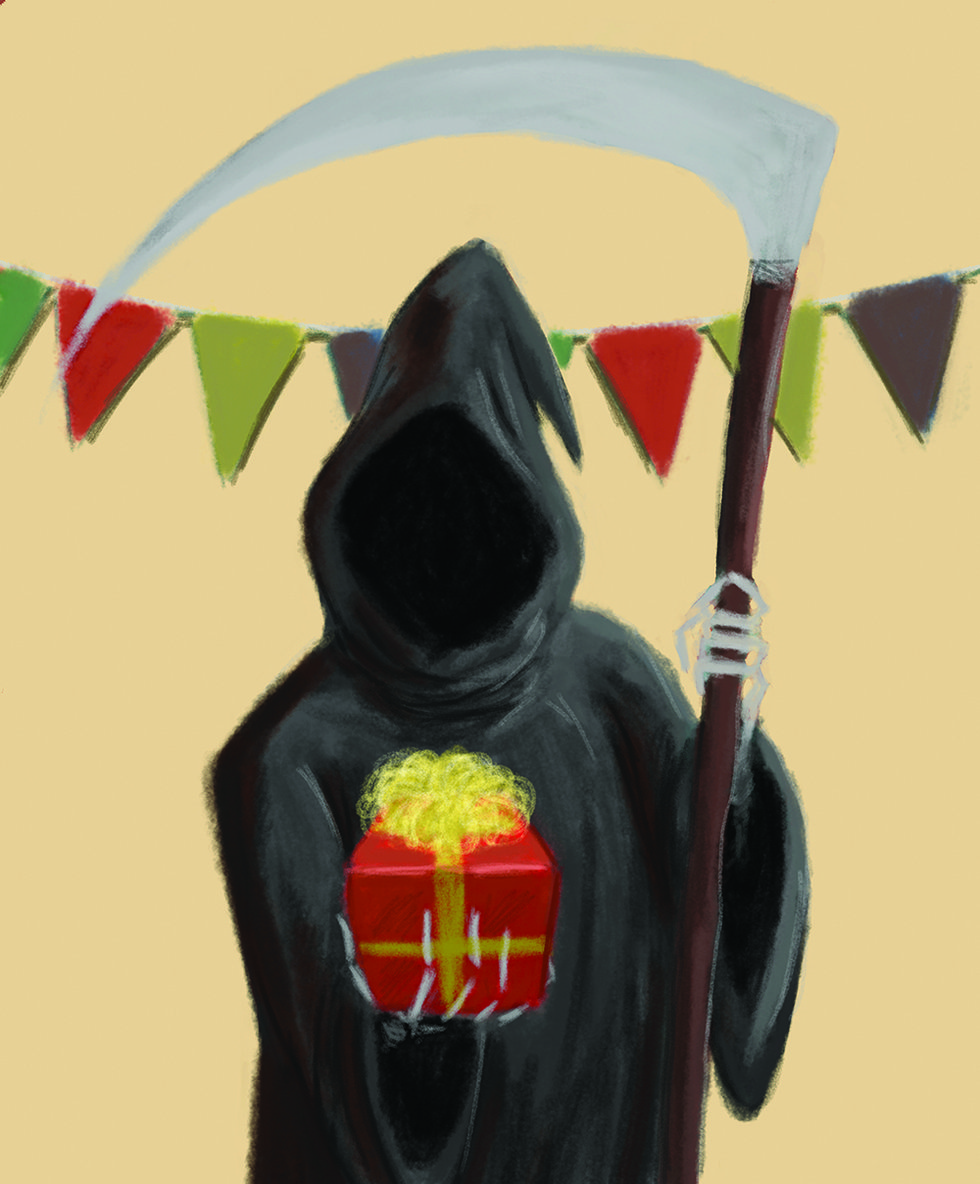 Illustrations by Brandon Hayman[/caption]
Illustrations by Brandon Hayman[/caption]
The Dying
“It is the most supremely interesting moment in life, the only one in fact when living seems life,” wrote Alice James — William and Henry James’ sister — as she faced death.
Whenever I experience some tragedy in life that brings me to my knees, there is also a death to my “self” that happens, which then strips away my ego. All spiritual transformations and religious conversions speak of this. Nature does too after a roaring forest fire burns thousands of years of story to only be reborn in new growth that is stronger. I have to ask myself, is the key to a more meaningful and deeper life usually comes after facing death, figuratively or literally? “All life is lived in the shadow of its own finitude, of which we are always aware — an awareness we systematically blunt through the daily distraction of living. But when this finitude is made acutely imminent, one suddenly collides with awareness so acute that it leaves no choice but to fill the shadow with as much light as a human being can generate — the sort of inner illumination we call meaning: the meaning of life,” Maria Popova of The Marginalian n wrote in an essay.
I watched the movie “Marcel the Shell” the other day, and at the end, the main character, Marcel, reflects on a great loss, the loss of his beloved grandmother, Connie, also a shell played by Isabella Rossellini. Before Connie dies, she led Marcel to a quiet place to perch in the basement where the window was always cracked. There the wind blew through Marcel’s shell creating a new sound, a new experience. In the face of loss, Marcel experiences the meaning of life. “It connected me, I felt, to everything. Because if I wasn’t there, the sound wouldn’t exist, and I felt like everything was in pieces, and I stood there and suddenly we were one large instrument. I like to go there a lot because it reminds me that I am not just one separate piece rattling around in this place, but that I am a part of a whole. And I truly enjoy the sound of myself connected to everything,” Marcel says.
Just before she dies, Connie reads the poem “The Trees” by Philip Larkin.
The trees are coming into leaf
Like something almost being said;
The recent buds relax and spread,
Their greenness is a kind of grief.
Is it that they are born again
And we grow old? No, they die too,
Their yearly trick of looking new
Is written down in rings of grain.
Yet still the unresting castles thresh
In full-grown thickness every May.
Last year is dead, they seem to say,
Begin afresh, afresh, afresh.
We tend to look at death as a failing of our bodies (or minds) when it is a natural part of living, of returning, of renewing. Experiencing death is one of the few things all humans have in common, which makes it a thing that connects us in our humanity like the wind in Marcel’s shell. I learned many lessons planning my death with The Art of Dying’s Buynak and Bell. Lesson 1: When that wave of grief hits, whether it is losing my father to cancer, my boyfriend to a breakup, or facing the end of my own life, I can’t swim against the current. I shall surrender to the fear and pain and fall back into the healing water until that final wave washes me ashore.
Lesson 2: To start living as if it could all end tomorrow and work with the doulas to plan a dinner party with my favorite people complete with toasts and convivial conversations about dying, loss, bucket lists, and to celebrate life.
Complete Article ↪HERE↩!
